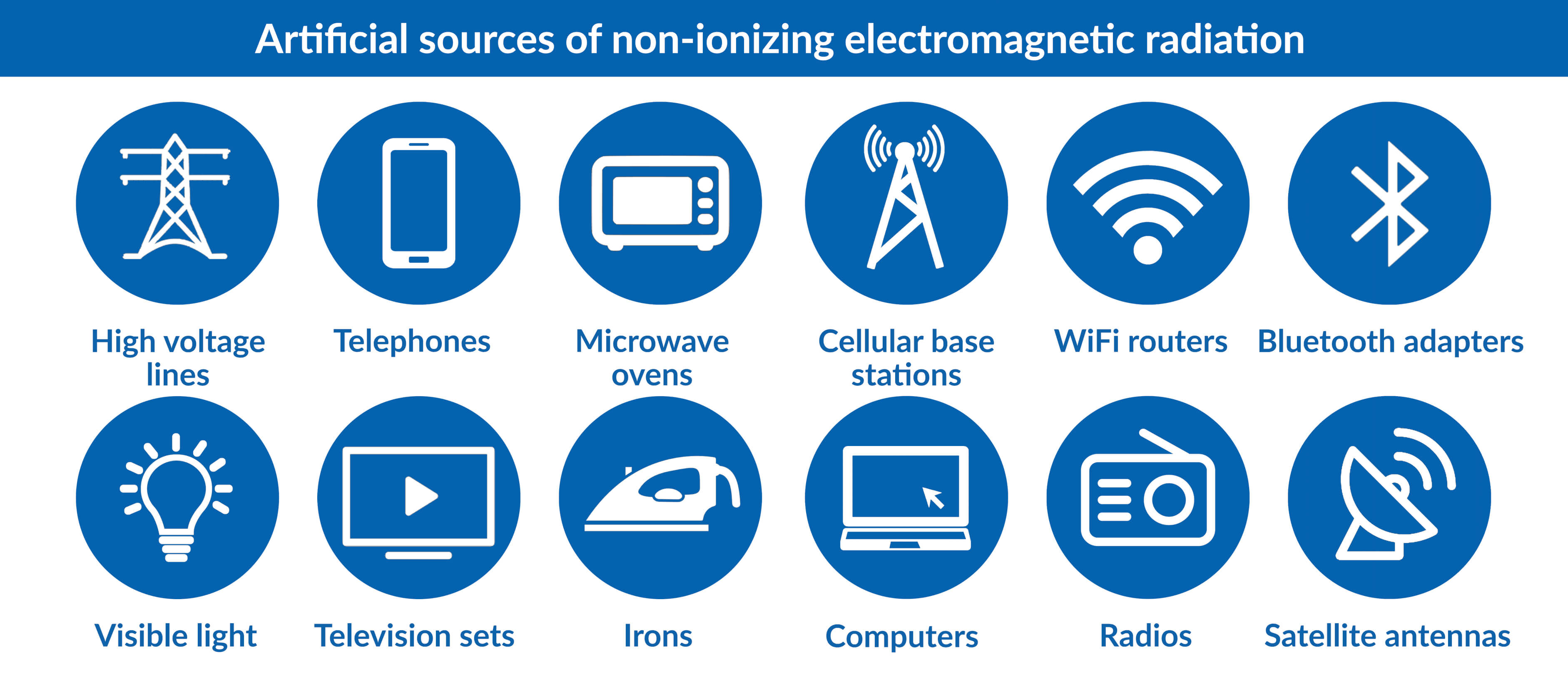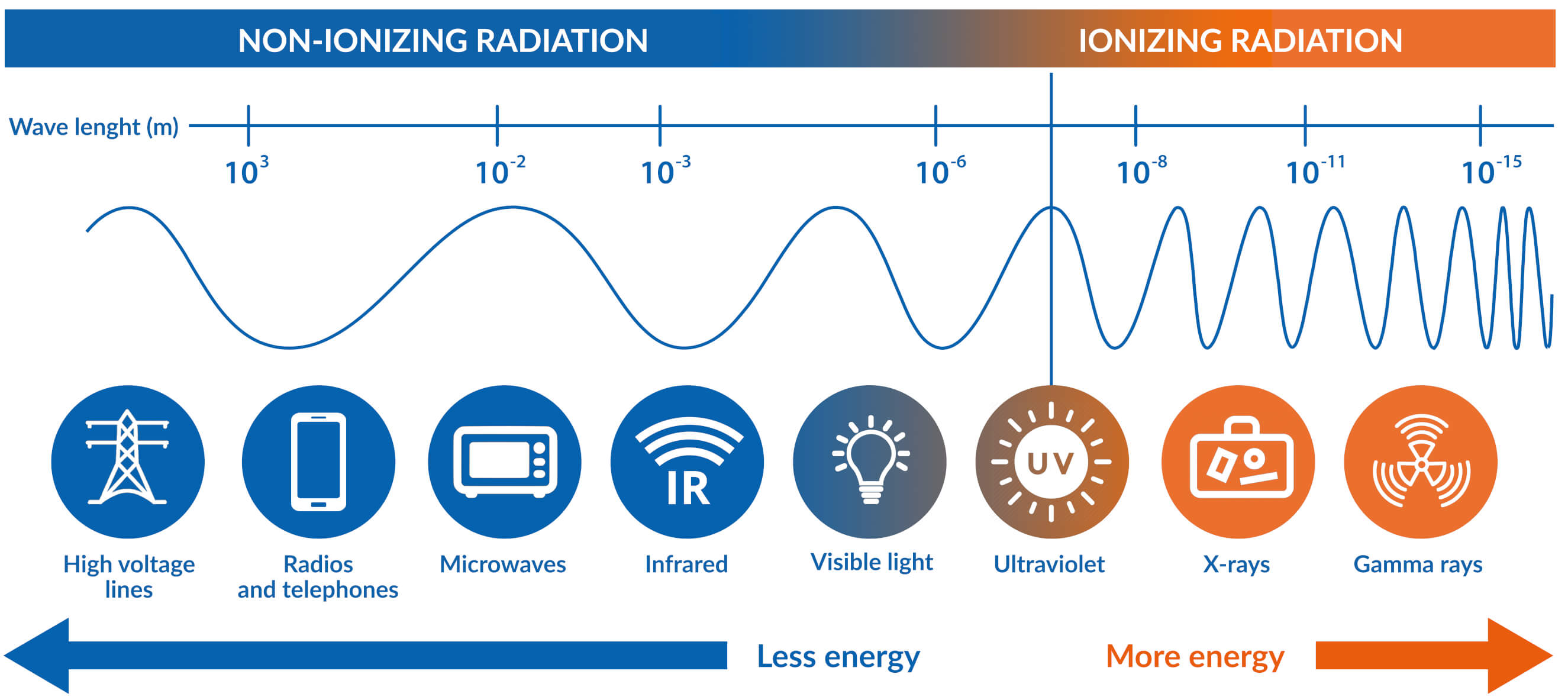What is an electromagnetic field (EMF)?
What is an electromagnetic field (EMF)?
An electromagnetic field (EMF) is a natural physical phenomenon present in the entire universe.
It is everywhere.
Natural sources of electromagnetic field are, among others:
Natural sources of electromagnetic field are, among others:
- the Earth, producing a magnetic field in its core;
- the sun, producing visible and invisible light (mainly infrared), solar wind;
- atmospheric phenomena related to lightning discharges;
- any matter with temperature exceeding absolute zero (−273°C);
- all human beings.
Devices generating an electromagnetic field
Devices and installations that are artificial sources of electromagnetic fields have been in use for about 150 years.
The number of such items has dramatically increased over time.
Most common are:
- power generators, radio, and terrestrial television;
- x-rays, CT scanners, MRI;
- radiotelephones, mobile networks, Wi-Fi, Bluetooth;
- radar, night vision, airport body scanner, luggage x-rays;
- microwave ovens, TV remotes, credit cards;
- quartz lamps, tanning beds, dental filling hardeners.

Types of electromagnetic waves
Science distinguishes electromagnetic waves according to their frequency.
Electromagnetic may be divided to:
Electromagnetic may be divided to:
- radio waves;
- microwaves;
- infrared radiation;
- visible light;
- UV light;
- x-rays;
- gamma radiation.
How electromagnetic waves interact with matter
Electromagnetic radiation can be classified as non-ionizing or ionizing, which depends on how waves interact with matter.
The conventional boundary between ionizing and non-ionizing radiation is the wavelength range covered by visible light.
Waves of frequencies below the mentioned boundary are non-ionizing, and those above - ionizing.
The non-ionizing nature of electromagnetic waves means that:
- they do not affect the human body negatively;
- they do not interfere with cell structure and are unable to modify nor affect the functions of its elements;
- they cannot destroy the atomic structure of matter because they do not affect the bonds between atoms;
- electromagnetic waves do not cause cumulative effect and their influence occurs only during exposure.
Telecommunication devices, including base stations or DVB-T transmitters using radio frequencies generate
a non-ionizing electromagnetic field only.

Applicable standards
The current EMF limit for frequencies above 2 GHz is 61 V/m and is approved by The Ministry of Health.
Measurements conducted in recent years all over Poland have shown that the intensity of the electromagnetic field in the environment is at an exceptionally low level and does not exceed the 7 V/m value.
More on the approach to the electromagnetic field in Poland:
- there are strict laws and regulations;
- the safety protocols (which define permitted EMF levels) are one of the most restrictive in the European Union;
- only professional authorized laboratories carry out the measurements;
- a state program for the monitoring of EMF levels is currently under development;
- studies on the potential impact of EMF on human health are regularly conducted.
EMF measurements
Electromagnetic field measurements require:
- compliance with applicable laws and regulations;
- compliance with measurement methods and conditions stated by the law;
- the use of professional, calibrated devices;
- including a correction for measurement error and a measurement uncertainty;
- an accreditation issued by the Polish Centre for Accreditation (PCA).
Electromagnetic field measurements are conducted by:
- the operators of radio-communication installations emitting an electromagnetic field;
- the Voivodeship Inspectorates of Environmental Protection to assess the levels of electromagnetic field in the environment and observe any changes as part of the State Environmental Monitoring Programme;
- other Inspectorate of Environmental Protection bodies, as part of planned inspections;
- the Voivodeship Inspectorates of Environmental Protection, at a justified request from a local government, including interventional inspections;
- the National Institute of Telecommunications as part of the measurement campaigns initiated by the Ministry of Digital Affairs
Expanded measurement uncertainty
As any other kind of measurement, EMF measurements are subject to some uncertainty.
A measurement cannot be considered 100% accurate because of a variety reasons:
inaccuracy of a measurement tool, a number of external factors, or even the technician taking the measurement.
Expanded measurement uncertainty allows creating a range which covers the result of a measurement with a certain level of probability, usually at 95%.
An example:
A measuring tool shows a result of 10 V/m while the assumed measurement uncertainty is +⁄− 30%, which in that case is 3 V/m.
The final result, in accordance with the practiced measurement methodology, is therefore: 10 V/m + 3 V/m = 13 V/m.
A measuring tool shows a result of 10 V/m while the assumed measurement uncertainty is +⁄− 30%, which in that case is 3 V/m.
The final result, in accordance with the practiced measurement methodology, is therefore: 10 V/m + 3 V/m = 13 V/m.
Easy to debunk EMF myths
It is a myth that:
- electromagnetic radiation surrounding us is a man-made artificial creation;
- any radiation is harmful to the human body;
- an antenna placed on the roof of a house is a threat to its residents;
- more base stations mean higher EMF;
- microwaves used in radio communication work like a microwave oven;
- an electromagnetic field created by a cellular network is as dangerous an radioactive field;
- radio-frequency radiation has been found to be a carcinogen;
- the farther the base station is located, the better, because the radiation is lower.